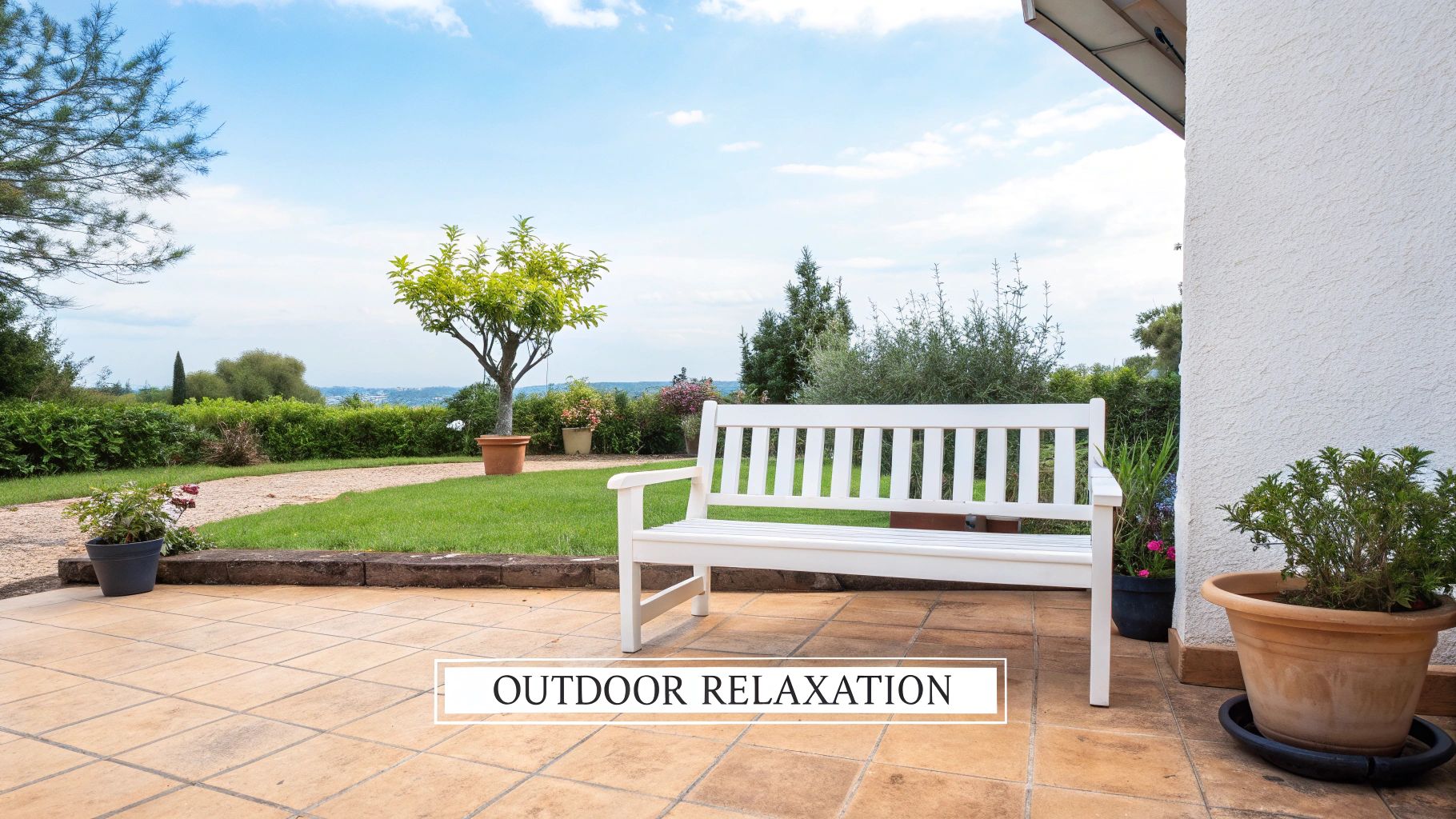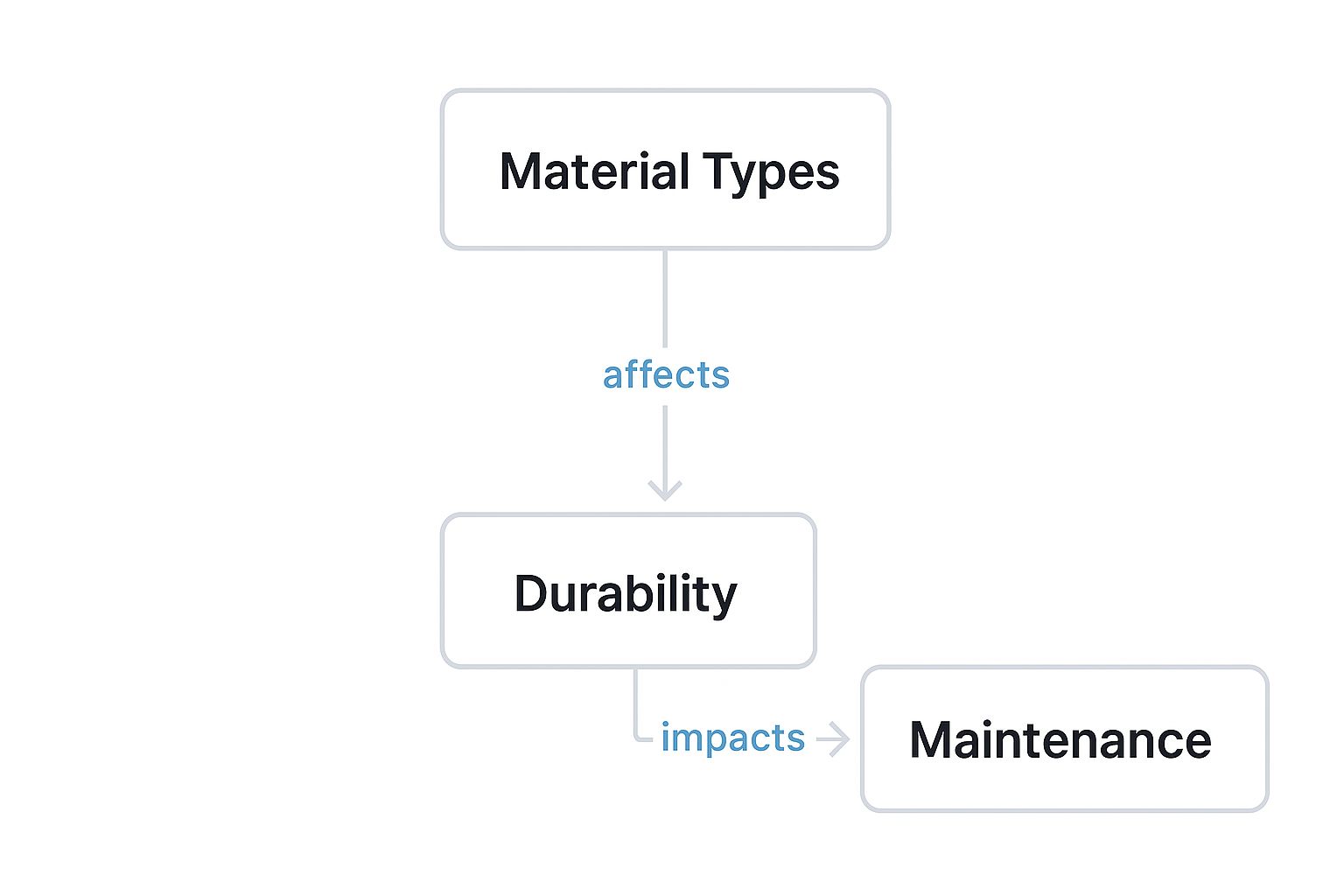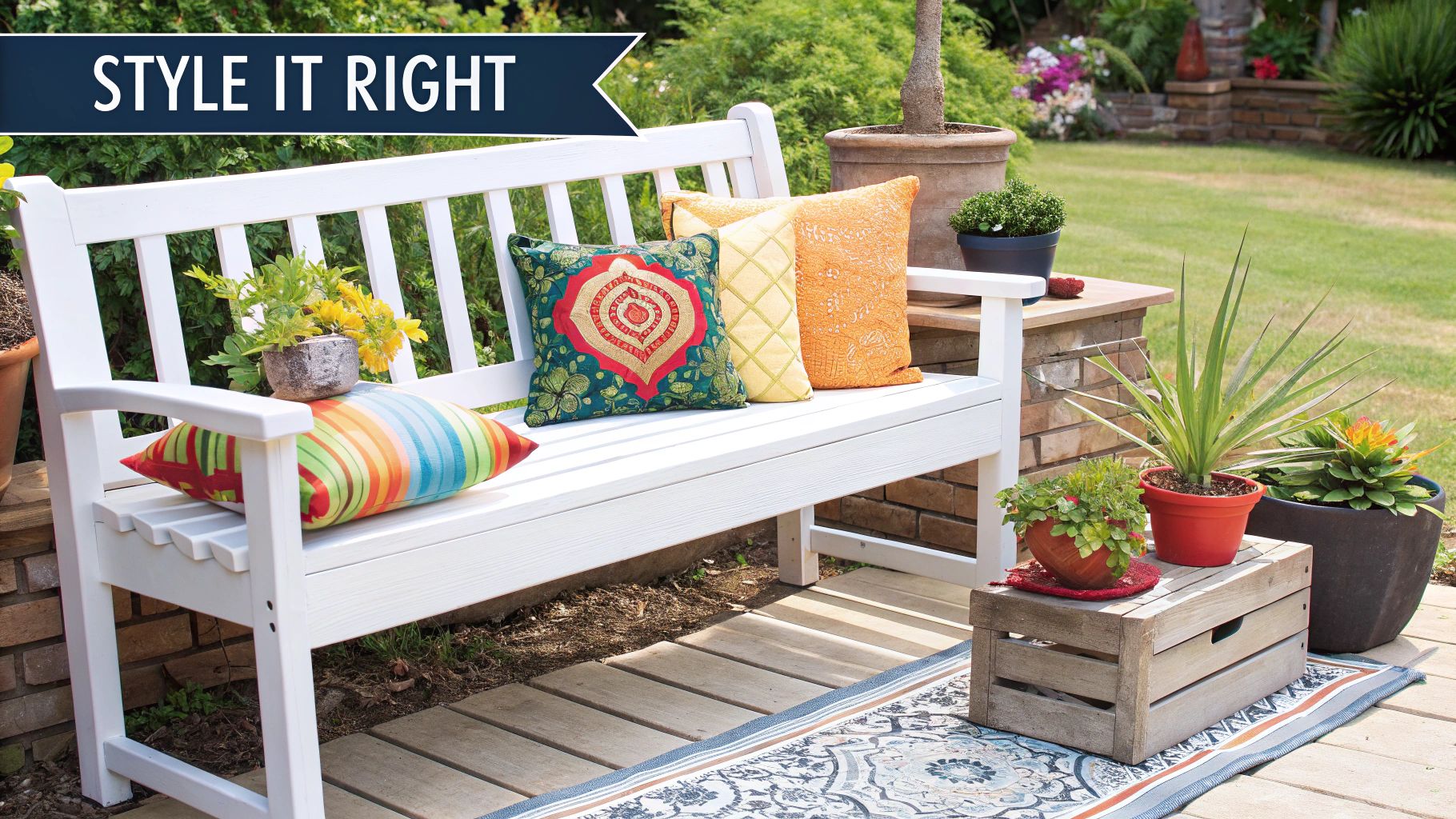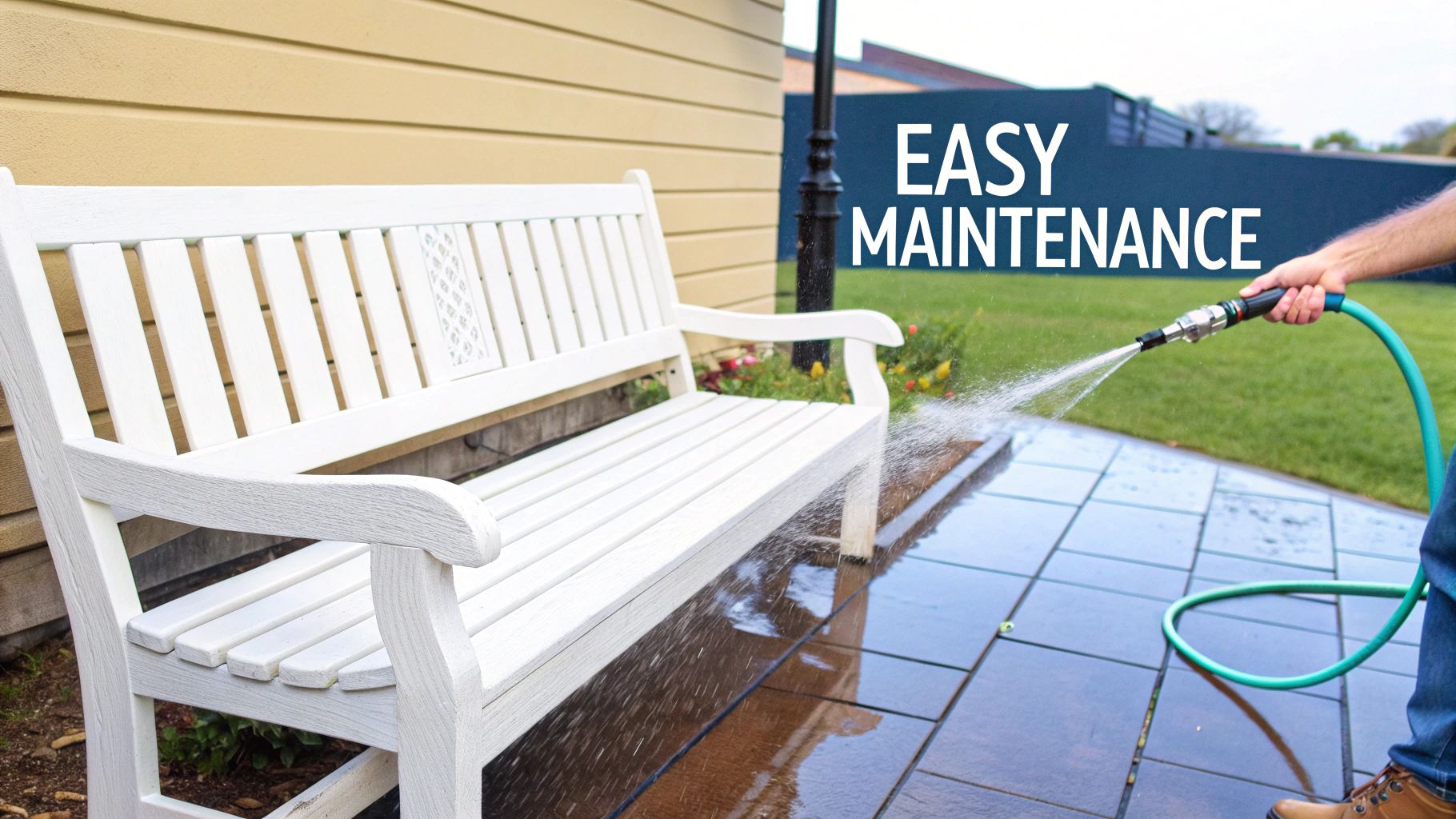A white outdoor bench seat is so much more than just a place to park yourself. It’s a classic design choice that brings a sense of light, elegance, and peace to any garden, patio, or backyard space. Think of it as a versatile focal point – one that looks just as good in a lush, traditional Aussie garden as it does on a sleek, modern deck.
The Timeless Allure of a White Garden Bench
There’s something about a white outdoor bench that just works. It acts as a subtle but powerful anchor in your garden design, almost like the perfect blank canvas. Picture it: set against a backdrop of deep green leaves or a riot of colourful flowers, the crisp white pops. It creates a beautiful contrast that naturally draws your eye and invites you to come and sit for a while. It brings a feeling of calm and order, turning any forgotten corner into a special little retreat.

This versatility is probably its biggest superpower. A single white bench can effortlessly shift its personality to match your space:
- Classic Charm: Placed in a traditional garden, it gives off serious English countryside vibes.
- Coastal Vibe: On a deck overlooking the water, it helps create that fresh, breezy Hamptons-inspired look we love in Australia.
- Modern Simplicity: In a minimalist backyard, its clean lines add a touch of structure without creating any visual clutter.
It's this adaptability that has made outdoor furniture such a massive part of Australian home life. In fact, the Australian furniture market, which includes beautiful pieces like these, is valued at roughly USD 10.86 billion. That number is set to grow as more of us put time and effort into making our outdoor living areas genuinely special. You can dig into more insights about the Australian furniture market through detailed industry reports.
When you get a handle on what makes a white bench so appealing, you can pick one that doesn’t just fill a gap but actually elevates the entire space. It’s really about creating an experience—that quiet spot for your morning coffee, a bit of extra seating for a family barbie, or just a picturesque feature that finishes off your garden view perfectly.
This guide is here to walk you through everything you need to know. We'll cover choosing materials that can stand up to the Aussie climate all the way to styling your bench for maximum impact. Let's find you a bench that’s tough, beautiful, and the perfect fit for your home.
Choosing the Right Material for Your Climate
Picking out a white outdoor bench seat is the fun part. The real challenge? Making sure it stays a brilliant white and doesn't fall apart under the harsh Australian sun and unpredictable weather. The material you choose is, without a doubt, the most critical decision you'll make. It dictates how long your bench will last and how much time you'll spend cleaning it versus enjoying it.
Think of it like choosing the right coat for winter. A light jacket might work in Sydney, but it won't do you much good during a Melbourne cold snap. Australia’s climate is incredibly varied, from the salty, humid air along the Queensland coast to the dry, blistering heat of Perth. A material that looks perfect in one backyard might crack, rust, or fade in another. Let's break down the best options to save you the headache later on.
Material Comparison for White Outdoor Benches
To make sense of the options, it helps to see them side-by-side. This table breaks down the most common materials, showing where they excel and what to expect in terms of upkeep and cost.
| Material | Best For (Climate) | Durability | Maintenance Level | Typical Cost |
|---|---|---|---|---|
| Powder-Coated Aluminium | Coastal, humid, and high-rainfall areas | High | Low | $$ - $$$ |
| Hardwood (e.g., Teak) | Most climates, but needs protection from extremes | Very High | Medium to High | $$$ - $$$$ |
| Poly-Resin (HDPE) | All-rounder; excellent for high-sun or wet areas | High | Very Low | $$ - $$$ |
| Wrought Iron/Steel | Dry, sheltered environments; not ideal for coastal | High (if kept dry) | High | $$$ - $$$$ |
Choosing the right material from the start means less work and more enjoyment for years to come. Think about your local weather first, then decide how much maintenance you're willing to do.
The Coastal Champion: Powder-Coated Aluminium
If you can smell the salt in the air from your backyard, you need to be strategic. Salt spray is relentless—it's the arch-nemesis of most metals, leading to the rust and corrosion that can quickly destroy outdoor furniture. This is where powder-coated aluminium truly shines.
Unlike iron or steel, aluminium simply doesn't rust. That gives it a massive head start. The powder-coating process then adds a super-tough, baked-on finish that acts like armour. It’s far more resilient than regular paint, holding its own against chipping, scratches, and the UV rays that cause other materials to fade.
A white bench made from aluminium is surprisingly lightweight for its strength, and keeping it clean is a breeze. A quick wipe-down with a bit of soapy water is usually all it needs.
The Timeless Classic: Hardwoods
There's an undeniable charm to hardwood. Timbers like teak or jarrah bring a natural warmth and a sense of permanence to a garden that other materials can't quite match. A solid hardwood bench, painted a crisp white, feels substantial and looks incredibly elegant.
But remember, not all woods are up to the task. You want to look for dense, oil-rich hardwoods like teak, which have natural defences against moisture and rot. While they are built to last, they do require a bit of love to keep that white finish looking perfect. This means regular cleaning and, every few years, a fresh coat of quality outdoor paint to keep the timber protected.

As you can see, there's a trade-off. Aluminium gives you that low-effort durability, while classic timber offers a beautiful aesthetic that requires more consistent care to maintain.
The Set-and-Forget Solution: Poly-Resin
If your motto is "less work, more relaxing," then a high-quality poly-resin bench is your answer. Forget those flimsy, old-school plastic chairs. Modern poly-resin—often called HDPE (high-density polyethylene)—is a different beast altogether. It's engineered to be tough, sturdy, and almost indestructible.
Poly-resin is the ultimate all-rounder for Australian conditions. It’s completely waterproof, so it will never rot or splinter. Best of all, the white colour isn't just a surface coating; it's mixed right through the material itself. That means if it gets scratched, you won't see an ugly scar—just more white.
Even better, quality resin furniture is made with UV inhibitors. This is a crucial feature that stops the material from going brittle or turning a sad yellow after a few seasons in the sun, a common fate for cheaper plastics. For a truly worry-free white bench that can handle anything the sky throws at it, poly-resin is tough to beat.
Of course, no matter what you choose, protecting your investment is always smart. Our guide on selecting an outdoor furniture cover provides some great advice for every material. It's a simple step that can add years to the life of your bench, keeping it looking fantastic season after season.
Finding the Perfect Style and Size for Your Space

Alright, so you’ve figured out what material will best handle the Aussie climate. Now for the fun part: picking a white bench seat outdoor design that looks like it was always meant to be there. The right style and size can transform a bench from a random add-on into a thoughtful centrepiece, marrying looks with usability.
This is more important than ever, as we Aussies are pouring more love and money into our backyards. The outdoor bench market here is growing by a projected 7.5% annually, with a market size tipping USD 89.87 million. It’s clear we’re serious about creating beautiful outdoor spaces, so getting the style and proportions right really matters. You can dig deeper into the numbers on Australia's outdoor furniture market trends to see just how much this is taking off.
Let's walk through some of the most popular styles to help you find your perfect match.
Matching the Bench to Your Home's Vibe
Think of your outdoor area as just another room of your house. Your white bench seat outdoor should feel connected to your home's personality, whether that’s sleek and modern, classic and traditional, or somewhere in between.
- English Garden Charm: You know the look—ornate details, a beautifully curved backrest, and maybe some scrolled arms. This style is pure romance, perfect for creating a timeless feel in a cottage garden or a more formal, manicured space.
- Modern Minimalist: This is all about clean, straight lines and zero fuss. A minimalist bench is sharp, structural, and looks incredible on a contemporary patio or in a backyard with a really organised, geometric design.
- Coastal Hamptons: A true Aussie favourite that screams relaxed elegance. Hamptons-style benches usually have a classic slatted back and a simple, solid frame, giving off that breezy, welcoming vibe that’s ideal for a deck or veranda.
When you choose a style that echoes your home's architecture, the bench instantly becomes part of the bigger picture instead of just sticking out.
Getting the Proportions Just Right
Size is every bit as important as style. A massive bench will completely swallow a small balcony, while a tiny one will look lost and insignificant on a sprawling lawn. It's all about finding a happy medium.
Before you even think about clicking "buy," grab a tape measure. Mark out the bench's footprint on the ground where you want it to go. This simple trick lets you physically see the scale and make sure it fits the space without making things feel cramped.
Think about its main job, too. Is it for quiet morning coffees by yourself, or will it be overflow seating for the next family BBQ?
- For intimate spaces: A neat two-seater bench, usually around 120cm wide, is perfect. It tucks beautifully into a small patio, balcony, or a secret little corner of the garden.
- For social gatherings: If you love to entertain, a bigger three-seater bench (150cm to 180cm wide) is the way to go. It offers more seating and has a much stronger visual presence.
Nailing both the style and the size means you’ll end up with a white bench that not only looks fantastic but also works perfectly for how you live outdoors.
How to Style Your White Outdoor Bench
A white outdoor bench is a fantastic starting point, but the real magic happens when you start styling it. Think of your bench as a blank canvas; with just a few thoughtful touches, you can transform it from simple seating into a stunning garden feature that looks like it's straight out of a design magazine. It's all about layering colours, textures, and accessories to create an atmosphere that beckons you outside.

The easiest and most impactful way to start is with soft furnishings. Outdoor cushions and throws are your best friends here, injecting instant personality and, of course, comfort. They give you the freedom to play with pops of colour that you can swap out with the seasons, keeping your outdoor space feeling fresh and current all year round.
Add Colour and Texture with Soft Furnishings
Your white bench is the perfect neutral backdrop, which means you can really have fun with different colour palettes and patterns. The trick is to stick with fabrics made specifically for the outdoors. These materials are treated to stand up to the elements, resisting moisture, mildew, and fading from our harsh Aussie sun.
Here are a few popular themes to get you started:
- Nautical and Coastal: For that classic Hamptons vibe, pair your white bench with cushions in deep navy blue, crisp stripes, or even a subtle rope pattern. It’s a timeless look that never fails.
- Vibrant Botanicals: Why not echo the beauty of your own garden? Choose cushions with bold floral or leafy prints to create a seamless connection between your furniture and its natural surroundings.
- Earthy and Natural: If you're after a more subdued, calming atmosphere, look for textures like linen or hessian in neutral tones. Think beige, sage green, or a soft, cloudy grey.
The right cushions do more than just add colour; they invite people to sit down and stay a while. A bare bench is functional, but a bench styled with plush cushions becomes a destination—a cosy spot for a quiet read or a good chat.
This idea of using textiles to completely transform a piece of furniture is incredibly powerful. While we’re talking about outdoor benches, you can find similar inspiration for your indoor spaces in our guide on 11 creative ways to style your sofa with covers.
Create a Scene with Placement and Accessories
Where you put your bench is just as important as how you decorate it. Good positioning can turn it into a deliberate focal point. Try placing your white outdoor bench seat against a dark-coloured fence or a wall of deep green hedging; this creates a stunning contrast that makes the white really sing.
Another great idea is to position it facing a lovely view, whether that’s your favourite flower bed, a small water feature, or the spot where the sun sets. This gives the bench a clear purpose beyond just being a place to sit.
To finish the scene, just add a few simple accessories:
- Potted Plants: Flank the bench with pots of different sizes, filling them with lush greenery or colourful blooms.
- Outdoor Lighting: A string of solar-powered fairy lights draped above the bench or a few solar lanterns placed nearby can create a magical glow in the evening.
- A Small Side Table: A small, weather-resistant table is both practical and stylish, giving you a handy spot for a drink, a book, or a small pot plant.
Keeping Your White Bench Looking Brilliant
Let's be honest, the idea of keeping a white bench looking crisp and clean in the Aussie outdoors can seem a bit daunting. Between dust, bird droppings, and morning dew, it feels like a constant battle. But the reality is much simpler than you think.
The secret isn’t about back-breaking scrubbing. It’s all about a little bit of regular, gentle cleaning and getting onto any spills or marks quickly. For most common materials, like modern resins or powder-coated aluminium, a simple wash with some mild soap and water is all you need to lift off the daily grime. A tiny bit of effort now stops that dirt from setting in and becoming a real headache later on.
A Simple Cleaning Playbook
Different materials will need slightly different handling, but the golden rule is always the same: be gentle. Stay away from harsh, abrasive cleaners and stiff-bristled brushes. They can easily scratch the surface, creating tiny grooves where dirt loves to hide, which ironically makes your bench harder to clean in the long run.
Here’s a quick rundown for the most common materials:
- Resin and Poly-Furniture: Your best friends here are a soft cloth or a sponge and a bucket of soapy water. For any stubborn spots that won't budge, a simple mix of vinegar and water often does the trick.
- Painted Wood: Just use a soft, damp cloth. If you spot any chips in the paint, it’s a good idea to touch them up as soon as you can to stop any moisture from seeping into the wood underneath.
- Powder-Coated Aluminium: This stuff is incredibly tough. A quick wipe is usually all it needs, as the smooth finish does a great job of resisting dirt build-up in the first place.
If you run into persistent problems like mildew, a very diluted bleach solution can work, but always—always—test it on a small, hidden spot first to make sure it doesn't damage the finish.
The real game-changer is preventative maintenance. A quick five-minute wipe-down once a month is a whole lot easier than a two-hour deep clean at the end of the season. Staying ahead of the dirt is what keeps your white bench looking its best with minimal fuss.
Seasonal Care and Protective Measures
While regular cleaning is your day-to-day strategy, thinking about seasonal protection is what will really extend the life of your bench. It’s no surprise that the demand for long-lasting outdoor furniture is booming; the global public bench market is even projected to hit USD 2.27 billion by 2033. People everywhere are investing in creating beautiful, durable outdoor spaces, and you can see more on that in this public bench market analysis. For your own garden, protecting that investment is just as crucial.
During the harsher months, or if you know a big storm is on its way, throwing a fitted furniture cover over your bench is a brilliant move. A quality cover will shield it from rain, harsh UV rays, and falling leaves, which dramatically cuts down on the cleaning you’ll have to do. It’s such a simple way to preserve that clean, white colour.
And if you’ve added cushions to your bench, they need protecting too! To keep them looking fresh and stop mould from setting in, have a look at our handy guide on choosing the best waterproof outdoor cushions.
Finally, if you’re lucky enough to have space in a garage or shed, think about storing your bench there during the off-season. It’s the ultimate protection, keeping it completely safe from the elements and ready to bring back out the moment the sun starts shining again.
Got Questions About Your White Outdoor Bench? We’ve Got Answers.
Even when you think you’ve found the perfect style and material, a few questions can pop up. That’s completely normal. A white outdoor bench seat is a gorgeous addition to any garden, and you want to be sure it’ll hold up. Let's tackle some of the most common worries so you can choose with total confidence.
One of the biggest concerns we hear is whether that brilliant white will stay, well, white, especially under the harsh Aussie sun. It’s a fair question, but thankfully, it's one that modern materials have solved.
Will It Turn Yellow in the Sun?
In short: not if you buy a good one. High-quality outdoor furniture isn't just painted white; it's engineered to stay that way. Look for products made with powerful UV inhibitors either mixed into the material itself or baked into the finish. Think of it as a permanent, heavy-duty sunscreen for your bench, blocking the rays that cause that dreaded yellowing.
You’ll find the best performance from materials like:
- Powder-coated aluminium: The colour is baked right on, creating an incredibly tough, UV-resistant shell.
- UV-stabilised poly-resin: Protection is part of its DNA, mixed through the entire material, not just sitting on the surface.
- Properly sealed hardwood: A top-notch outdoor paint or sealant acts as a formidable barrier against the elements.
Sure, a super-cheap plastic bench might not fare so well, but investing a little more in proven, weather-resistant materials means your bench will keep its crisp, clean look for years to come.
The real secret is to check the product description for terms like "UV-resistant" or "UV-stabilised." This single feature is the best guarantee your white bench will stay white.
What’s the Best Choice for Salty Coastal Air?
Living by the sea is fantastic, but that salty air can be a nightmare for outdoor furniture. It’s not just the sun you’re fighting; it’s the corrosive salt spray that seems to get everywhere, accelerating rust on the wrong type of metal at a frightening pace.
For any home near the coast, powder-coated aluminium is the hands-down winner. Aluminium doesn't rust, so even if the tough powder-coating gets a tiny chip, the metal underneath won't start to corrode. High-density polyethylene (HDPE) resin is another brilliant option—it’s a high-grade plastic that simply doesn't care about salt or moisture.
How Do I Stop a Lightweight Bench from Blowing Away?
Strong winds can be a real issue, especially for lighter benches made from resin or hollow aluminium. Thankfully, securing your bench is pretty straightforward. Many benches actually come with pre-drilled holes in the feet, making it easy to bolt them straight onto your deck or patio. Problem solved.
If you’d rather not make it permanent, you could try placing discreet furniture weights or even a couple of small sandbags on the lower bars. Another simple trick is just good placement—positioning your bench against the house, a sturdy fence, or in a sheltered nook can make a huge difference.
At The Sofa Cover Crafter, our passion is making every seat in your home a beautiful, practical, and welcoming spot—whether it’s inside or out. While we’re busy perfecting your living room with our stylish and protective sofa covers, we hope this guide helps you create an outdoor sanctuary you’ll love. See how you can refresh your indoor spaces at https://thesofacovercrafter.com.


